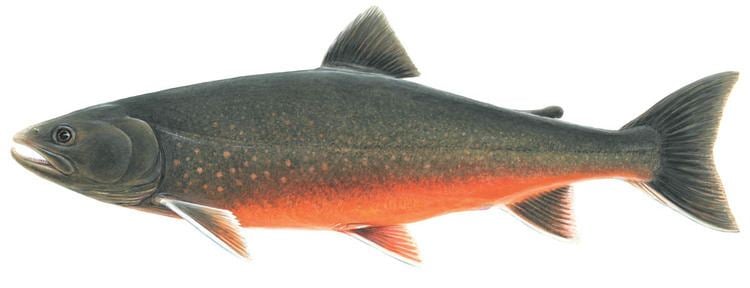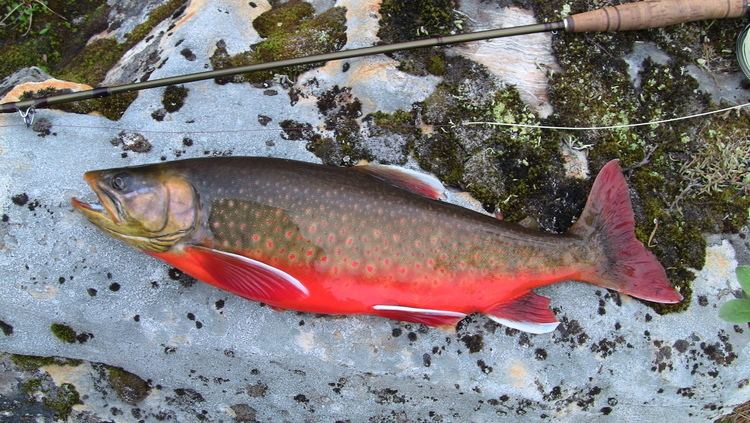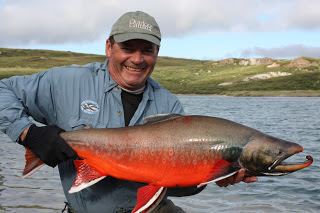Higher classification Salvelinus Rank Species | Scientific name Salvelinus alpinus Order Salmonids | |
 | ||
Similar | ||
Tree river 2015 arctic char plummers lodges
Arctic char or Arctic charr (Salvelinus alpinus) is a cold-water fish in the family Salmonidae, native to alpine lakes and arctic and subarctic coastal waters. Its distribution is circumpolar. It spawns in fresh water and populations can be lacustrine, riverine or anadromous, where they return from the ocean to their fresh water birth rivers to spawn. No other freshwater fish is found as far north; it is, for instance, the only fish species in Lake Hazen on Ellesmere Island in the Canadian Arctic. It is one of the rarest fish species in Britain, found mainly in deep, cold, glacial lakes, and is at risk from acidification. In other parts of its range, such as the Nordic countries, it is much more common, and is fished extensively. In Siberia, it is known as golets and it has been introduced in lakes where it sometimes threatens less hardy endemic species, such as the small-mouth char and the long-finned char in Elgygytgyn Lake.
Contents
- Tree river 2015 arctic char plummers lodges
- Arctic char lake trout fly fishing adventure in northern canada
- Name
- Subspecies in North America
- Spawning
- Diet
- Farming
- As food
- References

The Arctic char is closely related to both salmon and lake trout, and has many characteristics of both. The fish is highly variable in colour, depending on the time of year and the environmental conditions of the lake where it lives. Individual fish can weigh 20 lb (9.1 kg) or more with record-sized fish having been taken by anglers in northern Canada, where it is known as iqaluk or tariungmiutaq in Inuktitut. Generally, whole market-sized fish are between 2 and 5 lb (0.91 and 2.27 kg). The flesh colour can range from a bright red to a pale pink.

Arctic char lake trout fly fishing adventure in northern canada
Name

The arctic char was initially scientifically described in the salmon genus Salmo as Salmo alpinus by Carl Linnaeus in the 1758 edition of Systema Naturae, which is the work that established the system of binomial nomenclature for animals. At the same time he described Salmo salvelinus and Salmo umbla, which were later considered as Synonyms of S. alpinus. John Richardson (1836) separated them into a subgenus Salmo (Salvelinus), which now is treated as a full genus. The genus name Salvelinus is from German "Saibling" - little salmon.
Subspecies in North America

In North America, three subspecies of Salvelinus alpinus have been recognized. "S. a. erythrinus" is native to almost all of Canada's northern coast. This subspecies is nearly always anadromous. S. a. oquassa, known as the blueback trout or Sunapee trout, is native to eastern Quebec and northern New England, although it has been extirpated from most of its eastern United States range. S. a. oquassa is never anadromous. Dwarf Arctic char has been classified as S. a. taranetzi. These scientific names are not generally accepted, however, as the names S. a. erythrinus and S. a. taranetzi usually refer to subspecies that are endemic to Siberia only.

Arctic char are also found in Lake Pingualuit in the Ungava Peninsula, Quebec, a lake situated in an impact crater formed roughly 1.4 million years ago. Since the last glaciation, changing water levels are believed to have connected the lake with glacial runoff and surrounding streams and rivers, allowing char to swim upstream into the lake. Arctic char are the only fish found in the lake, and signs of fish cannibalism have been found.
Spawning

Spawning takes place from September to November over rocky shoals in lakes with heavy wave action and in slower gravel-bottom pools in rivers. As with most salmonids, vast differences in coloration and body shape occur between sexually mature males and females. Males develop hooked jaws known as kypes and take on a brilliant red colour. Females remain fairly silver. Most males set up and guard territories and often spawn with several females. The female constructs the nest, or redd. A female anadromous char usually deposits from 3,000 to 5,000 eggs. Char do not die after spawning like Pacific salmon and often spawn several times throughout their lives, typically every second or third year. Young char emerge from the gravel in spring and stay in the river from 5 to 7 months or until they are about 6–8 in (15–20 cm) in length.
Diet
The char diet varies with the seasons. During late spring and summer, they feed on insects found on the water's surface, salmon eggs, snails and other smaller crustaceans found on the lake bottom, and smaller fish up to a third of the char's size. During the autumn and winter months the char feeds on zooplankton and freshwater shrimps that are suspended in the lake and also occasionally feeds on smaller fish.
Farming
Research aimed at determining the suitability of Arctic char as a cultured species has been going on since the late 1970s. The Canadian government's Freshwater Institute of Fisheries and Oceans Canada at Winnipeg, Manitoba, and the Huntsman Marine Science Centre of New Brunswick, pioneered the early efforts in Canada. Arctic char are also farmed in Iceland, Estonia, Norway, Sweden, Finland, West Virginia, and Ireland.
Arctic char were first investigated because they were expected to have low optimum temperature requirements and would grow well at the cold water temperatures present in numerous areas of Canada. They could be an alternate species to rainbow trout and could provide producers with a different niche in the marketplace. The initial research efforts concentrated on identifying the culture needs and performance characteristics of the species. The Freshwater Institute was responsible for distributing small numbers of char eggs to producers in Canada; these producers in return helped determine the suitability of char in a commercial setting. Commercial char breeding stocks have now been developed largely from these sources.
In 2006, Monterey Bay Aquarium Seafood Watch program added farmed Arctic char as an environmentally sustainable Best Choice for consumers, stating: "Arctic char use only a moderate amount of marine resources for feed. In addition, Arctic char are farmed in land-based, closed systems that minimize the risk of escape into the wild."
As food
Commercial Arctic char typically weigh between 2 and 10 lb (1 and 4.5 kg). The flesh is fine flaked and medium firm. The colour is between light pink and deep red, and the taste is like something between trout and salmon.
